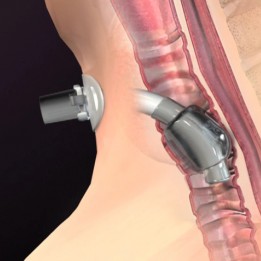Tracheostomy Tube Cuff: Purpose and Practice through Team Management
Michael S. Harrell, BS, RRT

Care of patients with tracheostomy has become a frequent topic of discussion in the medical industry and publications. Due to this focus, details related to the care plan of such patients are of concern and must be considered. This brief discussion highlights one aspect of patient care which has been noted to be of importance, the safety and efficacy of cuff deflation, especially when using a bias-closed position, no-leak Valve.
Purpose of a Cuff
The purpose of the inflated tracheostomy tube cuff is to direct airflow through the tracheostomy tube. This is typically during mechanical ventilation when the ventilator circuit must be closed to control and monitor ventilation for the ventilator patient, who frequently has a more seriously compromised system than patients not on a ventilator. The inflated cuff also may be important in cases of gross emesis or reflux when gross aspiration is present, to limit the penetration of aspirated material into the lower airway. The definition of aspiration is when any food, liquid, or other matter passes below the vocal folds. Therefore, the cuff cannot prevent aspiration as it is located below the vocal folds (see Figure 1). When neither mechanical ventilation or a risk of gross aspiration is present, the cuff should be deflated. Another consideration is to change the patient to a cuffless tracheostomy tube.
Inflated Cuff Considerations
The inflated cuff should be avoided whenever possible because it has the potential to cause multiple complications, such as:
- Increased risk of tracheal injury, including mucosal injury, stenosis, granulomas, and more;
- Diminished ability to use the upper airway, leading to disuse atrophy over time; and
- Restriction of laryngeal movement (laryngeal tethering) which may impact swallowing negatively.
Cuff Deflation
Deflating the tracheostomy tube cuff, when appropriate, has been shown to have multiple patient benefits, including:
- Reducing the risk of potential tracheal mucosal damage;
- Returning the patient to a more normal physiology, including closing the system through the use of a bias-closed position, no-leak Valve;
- Restoring speech and improving communication;
- Allowing for the possible improvement of the swallow;
- Potentially lowering the risk of aspiration;
- Allowing rehabilitation to begin as early as possible; and
- Decreasing the time to decannulation.
Cuff deflation is a recognized important step in the care plan for a patient with a tracheostomy (Speed & Harding, 2013). The benefits of cuff deflation can be safely and effectively extended to a patient with mechanical ventilation, when appropriate assessment and patient selection is performed (Sutt, Caruana, Dunster, Cornwell, Anstey, & Fraser, 2016). This early cuff deflation may decrease delays in the rehabilitation process, and potentially avoids the negative consequences related to the inflated cuff. The earlier that a patient has their cuff deflated, the earlier the patient may be weaned or decanulated. When decannulation is not a possible goal, cuff deflation may still accommodate the benefits outlined above on a long-term basis.
It has been demonstrated that a team of appropriately trained professionals armed with evidence-based guidelines significantly improves care and reduces negative outcomes for the patient with tracheostomy (de Mestral, 2011; Speed & Harding, 2013). A team approach assists with continuous monitoring and patient care plan management. As with any medical procedure or device, thorough education is important in achieving the desired outcomes. Providing the education, and competency verification necessary, is the duty of the organization providing healthcare services.
It is the responsibility of healthcare professionals to provide the best possible care to their patients. Proper cuff management, including cuff deflation, contributes significantly to the best practice plan of care for the patient with a tracheostomy. The safety and efficacy of the plan depends largely on the education and competency of the team caring for these individuals, as well as a commitment from the healthcare facility to a multidisciplinary tracheostomy team approach for patient care.
This article is from the Fall 2018 International Issue of Aerodigestive Health. Click here to view Tracheostomy Tube Cuff: Purpose and Practice through Team Management.
References:
de Mestral, C. (2011). Impact of a specialized multidisciplinary tracheostomy team on tracheostomy care in critically ill patients. Canadian Journal of Surgery, 54(3), 167-172. doi:10.1503/cjs.043209
Speed, L., & Harding, K.E. (2013). Tracheostomy teams reduce total tracheostomy time and increase speaking valve use: A systematic review and meta-analysis. Journal of Critical Care, 28(2), 216.e1-10. doi:10.1016/j.jcrc.2012.05.005
Sutt, A., Caruana, L.R., Dunster, K.R., Cornwell, P.L., Anstey, C.M., & Fraser, J.F. (2016). Speaking valves in tracheostomised ICU patients weaning off mechanical ventilation – Do they facilitate lung recruitment? Critical Care, 20(1), 91. doi:10.1186/s13054-016-1249-x











